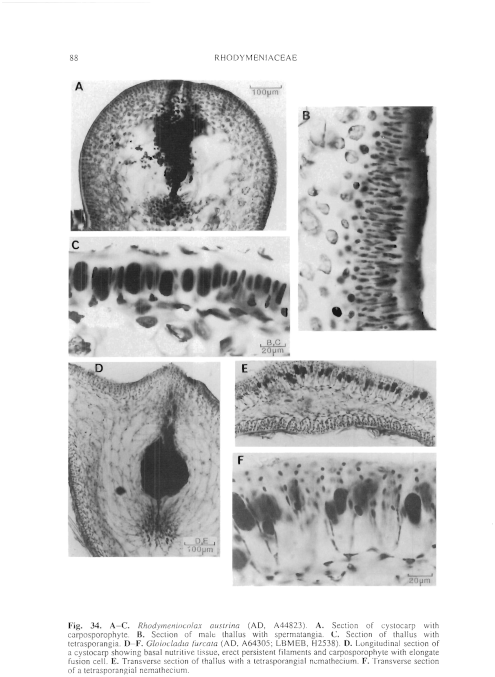|
|
|
|
|
|||||||||||
|
Electronic Flora of South Australia Species Fact Sheet
Phylum Rhodophyta – Class Florideophyceae – Order Rhodymeniales – Family Rhodymeniaceae
Thallus (Fig. 33A) 1–3 (–4) mm high, light red (drying paler or darker), simple or (usually) with a few irregular branches 1–1.5 (–2) mm long and 300–600 (–1500) µm in diameter, branch ends rounded, branches smooth (male and tetrasporangial) or verrucose (cystocarpic); base (Fig. 33B, C) short and broad; hemiparasitic on Rhodymenia. >Structure multiaxial, developing a cortex 2–3 cells thick near branch apices, becoming 4–6 cells thick (Fig. 33E) in mature branches, with anticlinal filaments, outermost cells ovoid, 3–5 (–6) µm in diameter. Medulla 0.5–1.2 mm and (10–) 15–25 cells across, cells of varying sizes, ovoid, larger cells 50–120 µm in diameter. Attachment to host (Fig. 33B–D) many cells broad, with filaments of small ovoid cells (15–) 20–50 µm in diameter penetrating the host medulla (Fig. 33D) and surrounding the medullary cells, often massed, with pit-connections to the host cells. Rhodoplasts discoid to laminate in cortical cells, generally sparse, sometimes ribbon-like in medullary cells.
Reproduction: Gametangial thalli dioecious; probably procarpic. Carpogonial branches 4-celled, borne on inner cortical supporting cells. Auxiliary cell branches not observed. Carposporophytes (Fig. 34A) erect, basal fusion cell branched, all gonimoblast cells forming ovoid to angular carposporangia 6–12 µm in diameter. Basal nutritive tissue moderate, erect filaments largely disintegrating. Cystocarps (Fig. 34A) protruding, hemispherical to slightly basally constricted, often clustered, 400–600 µm across, pericarp 10–15 cells and 100–150 µm thick, cells isodiametric, ostiolate. Spermatangia (Fig. 34B) in dense sori covering most of the surface, cut off from the ends of elongate, branched initials on surface cortical cells, ovoid, 2–4 µm in diameter.
Tetrasporangia (Fig. 34C) in extensive nemathecia, basally pit-connected to inner cortical cells, lying between paraphyses of elongate cells 2–5 µm in diameter, 20–30 µm long and 8–14 µm in diameter, decussately or cruciately divided.
Type from Crawfish Rock, Westernport Bay, Vic., 8 m deep (Watson & Womersley, 16.i.1974); holotype in AD, A44823.
Selected specimens: 20 km WSW of Outer Harbor, S. Aust., 22–25 m deep (McFarlane, 11.ix.1975; AD, A46618). 1.3 km off Cape Northumberland, S. Aust., 15 m deep (Shepherd, 7.vii.1977; AD, A55108). Gloucester Reserve, Williamstown, Vic., 1–3 m deep (Kraft et al., 8.v.1989; MELU, A38627, A38628 and van Amerongen, 25.vii.1990; MELU, A38629). Crawfish Rock, Westernport Bay, Vic., 4 m deep (Watson, 29.v.1974; AD, A44400).
Distribution: Off Outer Harbor, S. Aust., to Westernport Bay, Vic.
Taxonomic notes: The species of Rhodymenia which are hosts to Rhodymeniocolax are uncertain, but may fall within broad concepts of R. australis.
R. austrina differs from the type species, R. botryoidea, in habit (being more erect), in having a cortex of anticlinal filaments and in having tetrasporangia in nemathecia; R. botryoidea has a parenchymatous cortex and tetrasporangia scattered in the cortex (Sparling 1957, p. 362, fig. 13d-f). The Australian species may be more closely related to the unnamed British species (L. Irvine & Guiry 1983, p. 97).
References:
IRVINE, L.M. & GUIRY, M.D. (1983). Rhodyméniales. In Irvine, L.M. (1983). Seaweeds of the British Isles. Vol. 1 Rhodophyta Part 2A Cryptonemiales (sensu stricto), Palmariales, Rhodyméniales. (British Museum (N.H.): London).
SPARLING, S.R. (1957). The structure and reproduction of some members of the Rhodymeniaceae. Univ. Calif Pubis Bot. 29, 319–396.
The Marine Benthic Flora of Southern Australia Part IIIB complete list of references.
Publication:
Womersley, H.B.S. (28 June, 1996)
The Marine Benthic Flora of Southern Australia
Rhodophyta. Part IIIB. Gracilarialse, Rhodymeniales, Corallinales and Bonnemaisoniales
Reproduced with permission from The Marine Benthic Flora of Southern Australia Part IIIB 1996, by H.B.S. Womersley. Australian Biological Resources Study, Canberra. Copyright Commonwealth of Australia.
Illustrations in Womersley Part IIIA, 1996: FIGS 33, 34 A–C.

Figure 33 enlarge
Fig. 33. Rhodymeniocolax austrina (AD, A44823). A. Habit of thalli on Rhodymenia (spermatangial left, cystocarpic right). B. Longitudinal section of cystocarpic plant, host at base. C. Longitudinal section of attachment to host (on left). D. Small-celled filaments of parasite between larger cells of host. E. Longitudinal section of Rhodymeniocolax through cortex and medulla.

Figure 34 enlarge
Fig. 34. A–C. Rhodymeniocolax austrina (AD, A44823). A. Section of cystocarp with carposporophyte. B. Section of male thallus with spermatangia. C. Section of thallus with tetrasporangia. D–F. Gloioclacha furcata (AD, A64305; LBMEB, H2538). D. Longitudinal section of a cystocarp showing basal nutritive tissue, erect persistent filaments and carposporophyte with elongate fusion cell. E. Transverse section of thallus with a tetrasporangial nemathecium. F. Transverse section of a tetrasporangial nemathecium.

|
Email Contact: State Herbarium of South Australia |

|